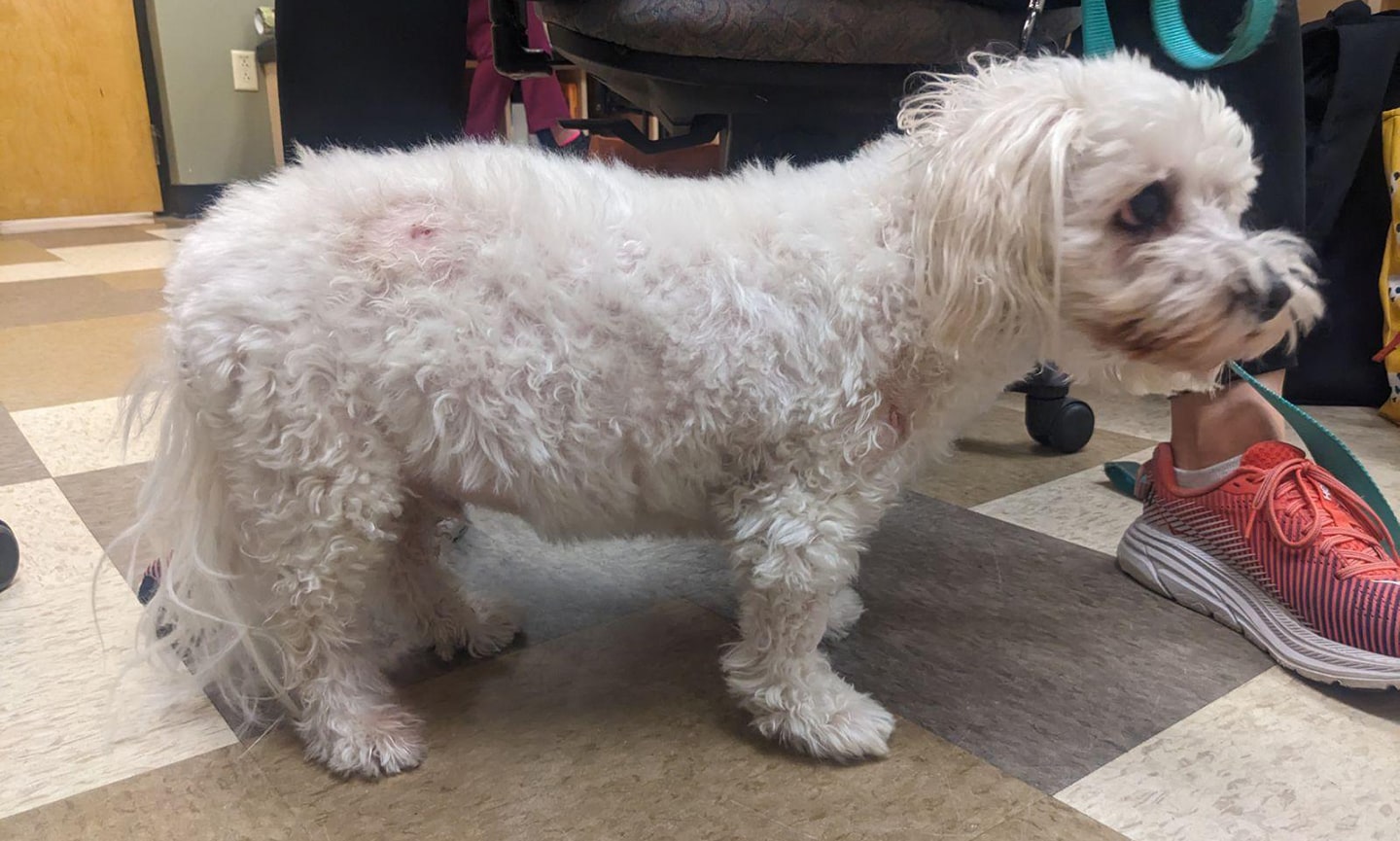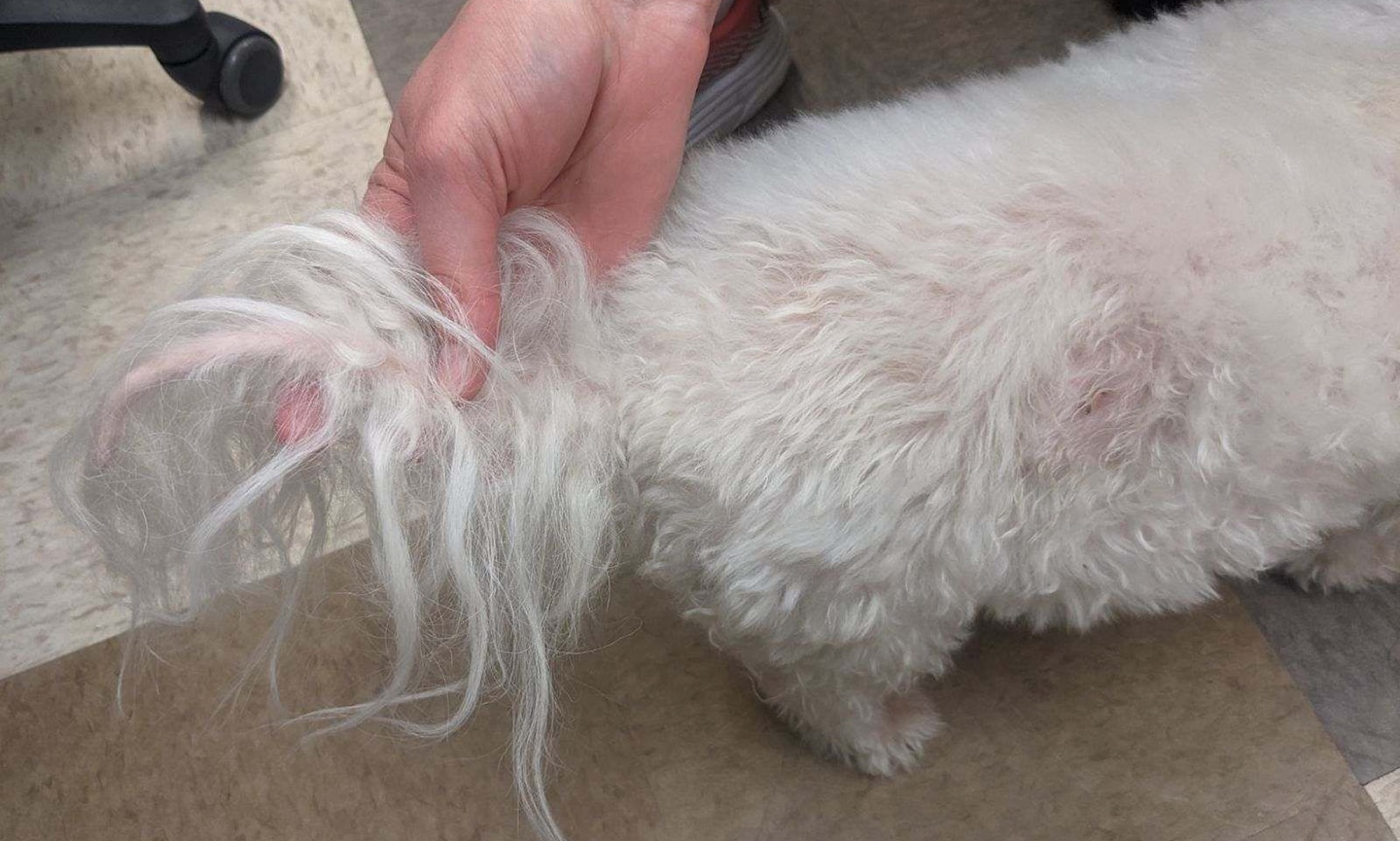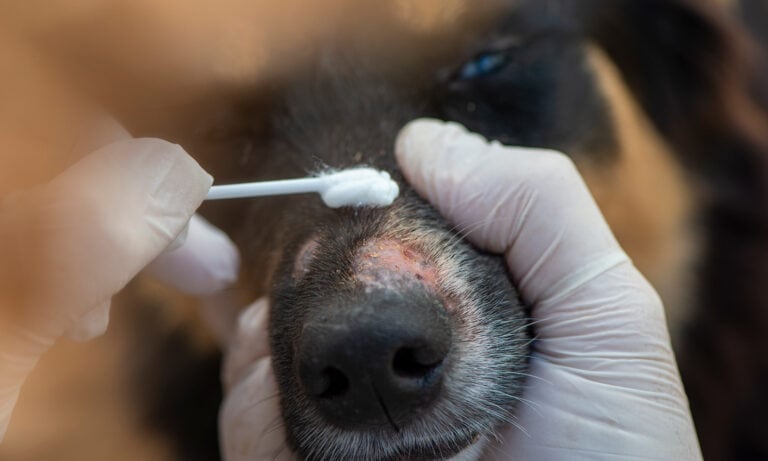Does your dog seem to have an endless appetite, a constantly bloated belly or an unquenchable thirst? These could be signs of Cushing's disease.
Also called Cushing’s Syndrome or hyperadrenocorticism, Cushing’s disease in dogs can be a serious medical issue that often requires treatment. We talked to vet experts to learn what Cushing's disease in dogs is, symptoms to look for in a dog with Cushing’s disease, treatment options and more.
What Is Cushing's Disease in Dogs?
A dog can develop Cushing’s disease when their body produces too much cortisol, a hormone responsible for responding to stress, aiding the immune system and helping to maintain body weight.
Cortisol is produced by your dog’s adrenal glands, which sit just on top of their kidneys.
When a dog develops Cushing’s disease, it “can lead to negative effects and damage the body,” says Alison Birken, DVM, a veterinarian at Victoria Park Animal Hospital in Ft. Lauderdale, Florida.
Dogs at Greater Risk of Cushing’s Disease
Middle-aged to older dogs are at a greater risk of developing Cushing’s disease than younger dogs.
Additionally, some breeds are more prone to Cushing’s than others, including:
What Causes Cushing’s Disease in Dogs?
There are three causes of Cushing’s disease in dogs.
1Pituitary Tumor
When a tumor develops on the pituitary gland (which is located at the base of the brain), a dog can develop Cushing’s, known as pituitary dependent hyperadrenocorticism (PDH). Pituitary tumors are responsible for 80-85 percent of cases of Cushing’s disease in dogs.
Most of these tumors are benign, or non-cancerous. Dr. Birken says cancerous tumors are notably less common.
2Adrenal Tumor
A majority of the remaining cases of Cushing’s disease in dogs are caused by adrenal gland tumors. Adrenal glands are located near a dog’s kidneys. When a dog develops Cushing’s disease from an adrenal gland tumor, it’s called adrenal-dependent hyperadrenocorticism (ADH).
“Adrenal tumors … can be benign or cancerous,” says Dr. Birken. The chances of the tumors being benign (non-cancerous) or malignant (cancerous) are equally probable, she says.
3Iatrogenic Cushing’s Disease
Another possible cause of Cushing’s disease is from the prolonged use of corticosteroid medication, including prednisone, dexamethasone and methylprednisolone.
Vets prescribe corticosteroids for a number of issues, including allergic and inflammatory conditions and cancer.
What Are the Symptoms of Cushing’s in Dogs?
When it comes to Cushing’s disease in dogs, symptoms can include the following:
- Increased thirst
- Increased urination
- Increased appetite
- Excessive panting
- Pot-bellied appearance
- Hair loss
- Recurrent skin infections, ear infections and urinary tract infections
- Thin skin
- Lack of energy
With Cushing’s disease, dog behavior that’s out of the norm and may be especially noticeable to pet parents includes increased appetite and lack of energy.
Pictures of Dogs with Cushing’s Disease
What does Cushing’s disease look like? Mei Lun Mui, DVM, an assistant professor at Colorado State University College of Veterinary Medicine who specializes in endocrine and infectious diseases, shares the following photos, with the dog parent’s permission.
There are a few important Cushing’s-related characteristics to note in these photos, says Emily Seidel, DVM, an internal medicine veterinarian with Colorado Animal Specialty & Emergency (CASE) in Boulder, Colorado.
- Distended abdomen: This dog has the pot-bellied appearance that’s characteristic of Cushing’s disease. In the first photo, their abdomen is swollen, causing it to look rounder or more distended than it would normally be.
- Rat tail: When a dog has Cushing’s, hair loss along their tail can make it look like a rat’s tail, which is naturally hairless. If you look at the second photo, you can see where this dog has lost hair, especially toward the end of their tail.
- Thinning hair: Hair loss in general is a common symptom of Cushing’s disease, and in these photos, you can see that the dog has lost hair along their side.
Diagnosing Cushing’s Disease in Dogs
If you suspect your dog could have Cushing’s disease, the first step is to make an appointment with your vet.
Initially, your pup’s vet will likely:
- Perform a physical examination
- Ask questions about your dog’s symptoms
- Perform blood tests
- Perform a urinalysis
“If, based upon initial assessment and screening tests, your veterinarian suspects Cushing’s disease, more specific blood and urine diagnostic tests for Cushing’s disease will be performed,” says Dr. Birken, including some or all of these:
- Low-dose dexamethasone suppression test
- ACTH stimulation test
- High-dose dexamethasone suppression test
- Urine cortisol creatinine ratios
- Abdominal ultrasound
Treating Cushing’s Disease in Dogs
If your dog has symptoms of Cushing’s disease that necessitate treatment, the course of action depends on the type of Cushing’s your dog has.
1Pituitary Dependent Hyperadrenocorticism
Pituitary dependent hyperadrenocorticism is treated with medication.
Vetoryl®, also known as trilostane, is an FDA-approved medication for use in dogs with Cushing’s syndrome, as it is considered safer with fewer side effects. It stops the adrenal glands from producing cortisol.
Note that Vetoryl® is not safe for dogs who are pregnant, have kidney or liver disease, or are taking certain heart medications.
The most common Vetoryl® side effects include:
- Diarrhea
- Lack of energy
- Reduced appetite
- Vomiting
- Weakness
Another medication sometimes used to treat Cushing’s disease in dogs is mitotane. Mitotane is FDA-approved for human use under the brand names Lysodren® and generic mitotane. It's currently not FDA-approved as a veterinary medication, but it is readily utilized in the veterinary field, and veterinarians can legally prescribe certain human drugs in animals in certain circumstances. This is called extra-label or off-label use because this use isn’t described on the drug label.
Your vet will discuss the best option for treating your dog. Generally, your dog will require treatment for life, and you’ll need to take your pooch to the vet for follow-up visits and tests so your vet can monitor your dog to ensure medication doses are appropriate.
2Adrenal Dependent Hyperadrenocorticism
Similarly, a vet will determine the best course of treatment for a dog who has been diagnosed with adrenal dependent hyperadrenocorticism. Dr. Birken says your vet may also recommend or perform advanced imaging such as an abdominal ultrasound to determine whether the tumor has spread to other areas of your dog’s body.
In some cases, with a board-certified surgeon, adrenalectomy (surgical removal of the adrenal glands) may be recommended, but it is generally considered high-risk surgery with a high complication rate. Therefore, often medications are also used for adrenal dependent hyperadrenocorticism.
If your vet determines medication is the best route, they may choose to use Vetoryl®. In addition to being FDA-approved to treat pituitary dependent hyperadrenocorticism, it’s also approved to treat adrenal dependent hyperadrenocorticism in dogs.
Your vet knows your dog’s medical history and the details of their adrenal dependent hyperadrenocorticism—such as whether the tumor that’s causing it is an adenoma (non-cancerous) or a carcinoma (cancerous), and whether it has spread to other areas of the body—and they can help you decide how to treat your dog.
3Iatrogenic Cushing’s Disease
For iatrogenic Cushing’s disease, the solution is typically to gradually wean your pooch off the corticosteroid medication.
Dr. Birken cautions that the weaning process must be slow. Taking the med away too fast can cause life-threatening conditions, because longer-term steroid use can impair adrenal function. Your vet will give you weaning instructions that you must follow carefully.
FAQs About Cushing’s Disease in Dogs
Q:
How long will a dog live with Cushing’s disease?
A:
For a dog with Cushing’s disease, life expectancy varies, says Sabrina Kong, DVM, certified canine rehabilitation practitioner at Jules Veterinary Center in Tracy, California.
She says life expectancy is dependent on many factors, including:
- The dog’s overall health
- The type of Cushing’s the dog has
- How well the condition is managed
“With proper treatment, many dogs with Cushing’s disease can live an average lifespan, though they may require lifelong medication and regular monitoring,” Dr. Kong says.
Q:
Is there a cure for Cushing’s disease in dogs?
Q:
Is it worth treating a dog with Cushing’s disease?
A:
“Whether it’s worth it to treat a dog with Cushing’s is a deeply personal decision,” says Dr. Kong. “From my perspective, treatment can significantly improve the quality of life for dogs with Cushing’s, allowing them to enjoy their days with minimal discomfort.”
She says that managing Cushing’s involves notable commitment and cost, but many pet parents “find the emotional and physical benefits to their beloved pet well worth the effort.”
Q:
What is the cost of treating hyperadrenocorticism in dogs?
Q:
What dietary changes can help manage Cushing’s disease in dogs?
Q:
Can Anipryl® help my dog with Cushing’s?
Read More
Share:













